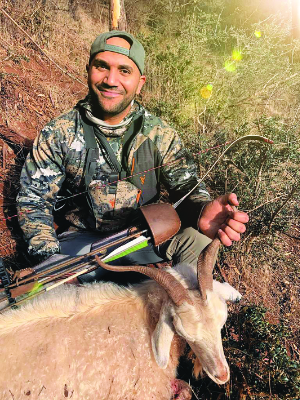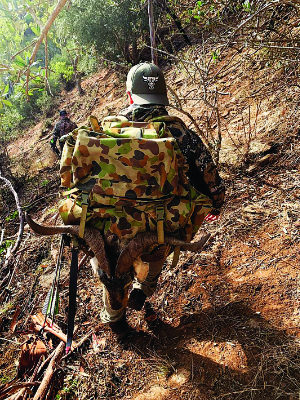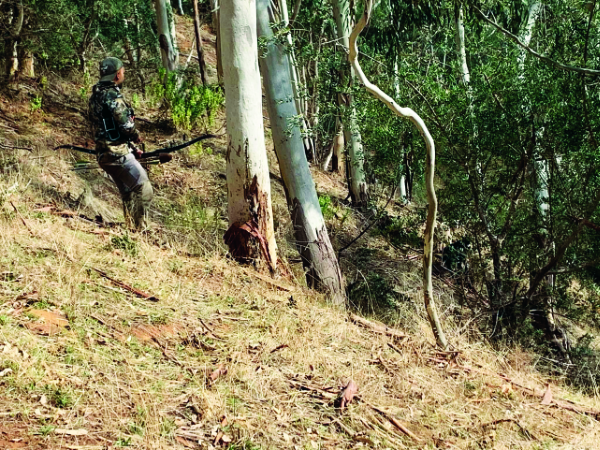The car shuddered to a halt. A large gum tree had been ripped from the ground during the night’s storm and the gritty gravel road to the cliffside edge had become impassable by car. Visions of first light shot opportunities on wandering billy goats were quickly replaced by premonitions of sweat and struggle. There was a lot of steep ground to cover, and we would have to move quickly to reach the top of the hillside before sunrise. The gang—Zach, Luke, and I, enthusiastically leapt from the car and geared up for the hike.
Now, before we advance in the storytelling, I am aware that in many places around the world goat hunting may be an unusual concept. I have received many messages from those who follow my adventures through other mediums that have asked why goats need to be hunted in the first place? The fact is that here in Australia feral goats cause millions of dollars of damage every year. They are a hearty animal, prolific breeders, and well adapted to many Australian landscapes. These swarms of goats create harsh food competition for our native animals and are responsible for terrible land degradation, destroying many native plants as well as farm crops.
Where I live in South Australia, there isn’t any public land for hunting. So, if you wish to help control the population of feral goats, you can only do it through private property access, which is difficult to come by. In short, there are sizable groups of goats causing notable land and property damage with very few people hunting them. As their population grows, the goats accumulate more significant levels of damage. Then, when the overall population becomes serious, and the price of goat meat is low, large-scale aerial cull operations are launched and thousands of goats are removed from the ecosystem. We are then again left with small, yet ever escalating numbers of goats, and so the cycle continues. Local hunters feel that it’s best to help landowners from the ground up, while the goat numbers are somewhat manageable. With permission granted, we head into the dangerous and inhospitable terrain these goats live in, relishing in the challenge that comes with hunting on steep cliff faces, curtained by hostile bush and scrub land, in search of adventure.
Now, back to the tale…
I’m ashamed to admit that I had packed a compound and my traditional bow for this trip. Although I was confident in my abilities with the recurve, I was still unsure if I could close the distance and pull it off. And, for some odd reason in my hasty packing the night before, that seemed to matter to me. Making the jump from wheels to strictly stickbow seemed like a great idea in my mind. In all honesty, the romance of the traditional world pulled at my heart and called me like a siren’s song, but now, the time had come to face the rocks and literally, take the goat by the horns. Opening the rear of the truck, I made an instinctive motion for the compound. With time against us and a long hike up, I reached for the easier option as a reaction. I instantly recoiled in disbelief. I was solely committed to the life of the stick and string for so long now, and I couldn’t believe that I had even considered bringing the “other” along. I had serious thoughts about what I wanted bowhunting to be for me while in preparation for this hunt, and in all those visions I never once saw a complex piece of equipment. It was the simplicity and the beauty of the traditional bow in my hand, while I walked in the wild world that I had imagined and nothing more. The allure of the traditional world to me, was to experience the hunt fully, to get close, to prolong the excitement and to wear the results, with a warm heart, fully thankful for whatever adventure arose. With all this in mind, I grasped the old Bear riser, shed the last of my attachments to the modern world of archery for good, and the boys and I were on our way.
After a few quick stops to rearrange our gear and shed some outer layers we were approaching the pinnacle of the hillside. A whisper of a breeze drifted toward us and carried the faint, yet unmistakable scent of feral billy goats. With each step up the steep dirt track the aroma amplified and collected on our faces like the beads of sweat on our brows. In this moment we were certain of two things; we were into the animals, but we obviously needed to work on our cardio.

The author’s first animal with a traditional bow, a feral nanny goat.
Somehow, we remarkably managed to beat the break of dawn. First light was slowly illuminating the morning through heavy overcast skies and Mother Nature was just waking up as we reached the peak. The air was thick with the smell of goat and we could hear a mob moving below us. Zach and I took the lead, moving slowly toward the first tribe. A few silhouettes dissipated as we approached, so we slowly crept in further, taking careful note to keep the wind in our favour. We moved toward the sounds of scattering rubble, knowing we were getting closer to a large group. Then, without warning, the goats materialized, as if spawned from the thick tree cover itself. They moved along the tracks and leisurely wandered toward their next destination. We had a good wind and they had not seen us yet. Suddenly, a pure white nanny presented herself on the ridge line and stood out in stark contrast to the gloomy morning light. Zach let out a small bleat and she stopped in close range to our front, broadside. This was it, an opportunity like this was more than I could have ever dreamt of. I drew back the bow, breathed, picked my spot, and let the arrow find its home. The shot felt good as it fell from my fingers and I watched the arrow pinwheel away, then disappear. The nanny darted off and crashed in a thicket of trees 15 yards away.
Moments later, before I had a chance to absorb what had just happened, more bleating sounded from the escarpment below us. We peered over the cliff’s edge and located a couple of large billies proudly standing on a boulder, overlooking the lands below. Zach let an arrow loose and it found its mark well on a large-bodied beast. Luke drew back, teetering on the precipice waiting for the second billy to present a shot but one did not arise. As Luke moved away from the edge, a thick-necked, pure black billy with curved devil horns mounted the rock dominantly. I balanced on the edge and stood ready for a few moments as the goat commanded the stone directly below me, unmoving, not offering a lethal shot. Then, within an instant, he leapt from the rock face and disappeared forever into my memories.
I moved to where the nanny stood when I set the arrow upon her and found a small patch of blood and a few spots leading down a path, into the trees. I located her bedded up, 15 yards away, and not moving a muscle. Perhaps the shot had not been as good as I originally thought. Quickly climbing back up the hillside, I looped around behind her. She stood up and a difficult quartering away shot presented itself. I took the opportunity fearing the moment would pass and threaded a perfect arrow in and out. She bolted but collapsed 20 yards away under an old olive tree. The first shot was lethal; the second brought swiftness to her passing. Waves of pure emotion washed over me, first sadness, then appreciation, and then I dare say even joy.

Hiking out of the ravine all packed up.
I left the nanny to rest in the shade and followed the percussion of a small hatchet up the embankment. I found Zach attempting to remove his broadhead from a tree. Upon approach, I realised the ground immediately to his rear was bathed in red. I moved in closer to get a better look at what he was doing and was shocked to find the body of a monstrous billy tangled in a tree branch, saved from a long, steep descent only by his enormous horns. Zach looked at me and smiled as he reclaimed his broadhead and then went back to work removing limbs from the branch to free the thick-necked beast. Then, without warning, the goat was loose, sliding down the embankment, taking Zach with him! It seemed that the billy’s last effort to reclaim his honour, even after being expelled from this world, was to take his sender with him. Luke and I watched in horror as Zach slid farther and farther down, at a faster and faster pace, breaking crumbling stone underfoot, and kicking dust into the air with every effort to stop. But somehow by sheer luck (or as Zach calls it, “pure skill”) he regained his footing and managed to slow down and pull the goat onto a small ledge by an old thick tree. The flat was enough to stop them both, just a few yards from a terrifying vertical drop.
Luke and I approached Zach and his harvest and marvelled in disbelief at the events that just unfolded. As we stopped to regroup and take photos, we were interrupted by the sound of a younger goat rummaging through the scrub, out of sight but presumably close. Zach called for Luke to get ready. He propped up his fallen billy and began to bleat and call the younger goat in. Slowly but surely curiosity took over and we soon had eyes on the goat. Cautiously, it began to move in our direction, but once it had seen the large patriarch resting against the old tree the goat ran in fast, closing the distance carefree. As it approached, the animal paused for one brief moment, giving Luke the perfect opportunity to free an arrow, and claim his goat for the day.
After a brief look of contentment between us, Luke disappeared into the scrub to track his goat while Zach and I went to reclaim mine. Zach went to drag the brilliant white nanny into the open as I collected my arrow, erect but buried deep in the dirt, the shaft and fletching standing as proud as a flag and mast signaling the day’s success. I removed the arrow, placed it into my quiver, and was greeted by a familiar smile from the bottom of the ravine—Luke, with two rather large (for a small goat) legs protruding from the top zip of his pack.
We spent the remainder of the morning processing my goat. As our blades peeled back the bounty of our harvest, the sky began to shed its clouds and reward us with sunlight. The radiant beams began to rain down on us in the opening on the hillside, illuminating the noble Bear riser, as if the bow itself was smiling with us. The smell of backstrap sizzling in butter, garlic, and spices filled the air and the laughs of good friends were shared freely. We were overwhelmed with the sense that this is what life is all about. All my expectations for the day had been greatly exceeded; in fact we were overflowing with gratitude and enjoyment as we ate in bliss, willfully ignorant to the difficulty and the danger of the hike back out with loaded packs, but that’s a story for another day.
The author lives in Australia, taking every spare moment from responsibilities of life to reconnect with his roots. He is currently teaching his three-year-old son to shoot a traditional bow and looks forward to the day when he can share a similar, although hopefully safer, adventure with him when he’s older. Also, there may be trouble if he doesn’t thank his wife for listening to endless talk about arrow flight and for giving him the time to enjoy the wilds of his native continent.
Equipment Notes: Ilias hunted with a Bear Takedown B riser, Thunderhorn quiver, Victory Trad carbon shafts tipped with Kayuga old school single bevel broadheads, and a Safari Tuff finger tab.







Leave A Comment